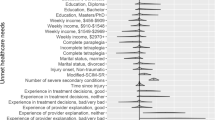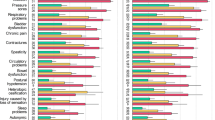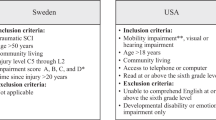Abstract
Study design:
Qualitative design using focus groups.
Objective:
To explore the perceptions of people with SCI and their caregivers about information needs and service delivery options that may assist them to maintain or improve their long-term health.
Setting:
Province wide project in Alberta, Canada.
Methods:
Eight focus groups were conducted; five with community dwelling people with SCI and three with unpaid caregivers (family and friends). Content analysis was used to identify categories and themes arising from the data.
Results:
The findings from the study are broader than the original objective to explore information needs and service delivery options to promote long-term health. The participants more globally discussed factors that contribute to or provide barriers to their long-term health. Those factors are captured in five categories, including readiness, information pathways, community health care, health promotion, and contextual factors. A framework that illustrates the relationships between categories was constructed.
Conclusion:
The framework identifies areas to target in programmes designed to reduce or prevent secondary conditions in people with SCI.
Sponsorship:
This study was funded by the Alberta Paraplegic Foundation and the Glenrose Rehabilitation Hospital Foundation.
Similar content being viewed by others
Log in or create a free account to read this content
Gain free access to this article, as well as selected content from this journal and more on nature.com
or
References
Nosek MA et al. Secondary conditions in a community-based sample of women with physical disabilities over a 1-year period. Arch Phys Med Rehabil 2006; 87: 320–327.
Bauman WA, Spungen AM . Disorders of carbohydrate and lipid metabolism in veterans with paraplegia or quadriplegia: a model of premature aging. Metabolism 1994; 43: 749–756.
Dryden DM et al. Utilization of health services following spinal cord injury: a 6-year follow-up study. Spinal Cord 2004; 42: 513–525.
Potter P, Wolfe D, Burkell J, Hayes K . Challenges in educating individuals with SCI to reduce secondary conditions. Top Spinal Cord Inj Rehabil 2004; 10: 30–40.
Cott CA . Client-centred rehabilitation: client perspectives. Disabil Rehabil 2004; 26: 1411–1422.
Kendall MB, Ungerer G, Dorsett P . Bridging the gap: transitional rehabilitation services for people with spinal cord injury. Disabil Rehabil 2003; 25: 1008–1015.
Rimmer JH . Health promotion for people with disabilities: the emerging paradigm shift from disability prevention to prevention of secondary conditions. Phys Ther 1999; 79: 495–502.
Stuifbergen AK, Rogers S . Health promotion: an essential component of rehabilitation for persons with chronic disabling conditions. ANS Adv Nurs Sci 1997; 19: 1–20.
Stuifbergen AK, Seraphine A, Harrison T, Adachi E . An explanatory model of health promotion and quality of life for persons with post-polio syndrome. Soc Sci Med 2005; 60: 383–393.
Prochaska JO, Velicer WF . The transtheoretical model of health behavior change. Am J Health Promot 1997; 12: 38–48.
Nieuwenhuijsen ER, Zemper E, Miner KR, Epstein M . Health behavior change models and theories: contributions to rehabilitation. Disabil Rehabil 2006; 28: 245–256.
Garner C, Page SJ . Applying the transtheoretical model to the exercise behaviors of stroke patients. Top Stroke Rehabil 2005; 12: 69–75.
Cardinal BJ, Kosma M, McCubbin JA . Factors influencing the exercise behavior of adults with physical disabilities. Med Sci Sports Exerc 2004; 36: 868–875.
Martin PC, Fell DW . Beyond treatment: patient education for health promotion and disease prevention. J Phys Ther Educ 1999; 13: 49–56.
Hollis V, Openshaw S, Goble R . Conducting focus groups: purpose and practicalities. Br J Occup Ther 2002; 65: 2–8.
Krueger R, Casey M . Focus Groups: A Practical Guide for Applied Research 3rd ed. Sage Publications:Thousand Oaks, California 2000.
Carpenter C . Using qualitative focus groups to evaluate health programmes and service delivery. In: Hammell KW (ed) Qualitative Research in Evidence Based Rehabilitation. Churchill Livingstone: Toronto 2004.
Duggleby W . What about focus group interaction data? Qual Health Res 2005; 15: 832–840.
May L, Day R, Warren S . Evaluation of patient education in spinal cord injury rehabilitation: knowledge, problem solving and perceived importance. Disabil Rehabil 2006; 28: 405–413.
Hsieh HF, Shannon SE . Three approaches to qualitative content analysis. Qual Health Res 2005; 15: 1277–1288.
Strauss A, Corbin J . Publisher: Basics of qualitative research: techniques and procedures for developing grounded theory. Sage Publications: Thousand Oaks 1998.
World Health Organization. International Classification of Functioning, Disability and Health. World Health Organization: Geneva 2001.
Strecher V, Wang C, Derry H, Wildenhaus K, Johnson C . Tailored interventions for multiple risk behaviors. Health Educ Res 2002; 17: 619–626.
Wolfe DL, Potter PJ, Sequeira KAJ . Overcoming challenges: the role of rehabilitation in educating individuals with SCI to reduce secondary conditions. Top Spinal Cord Inj Rehabil 2004; 10: 41–50.
May L, Day R, Warren S . Perceptions of patient education in spinal cord injury rehabilitation. Disabil Rehabil 2006; 28: 1041–1049.
Tang PC, Newcomb C . Informing patients: a guide for providing patient health information. J Am Med Inform Assoc 1998; 5: 563–570.
Tingstrom P, Kamwendo K, Goransson A, Bergdahl B . Validation and feasibility of problem-based learning in rehabilitation of patients with coronary artery disease. Patient Educ Couns 2002; 47: 337–345.
Lorig KR, Sobel DS, Ritter PL, Laurent D, Hobbs M . Effect of a self-management program on patients with chronic disease. Eff Clin Pract 2001; 4: 256–262.
Bodenheimer T, Lorig K, Holman H, Grumbach K . Patient self-management of chronic disease in primary care. JAMA 2002; 288: 2469–2475.
Cardinal BJ, Kosma M . Self-efficacy and the stages and processes of change associated with adopting and maintaining muscular fitness-promoting behaviors. Res Q Exerc Sport 2004; 75: 186–196.
Stuifbergen AK, Becker HA . Predictors of health-promoting lifestyles in persons with disabilities. Res Nurs Health 1994; 17: 3–13.
Lorig K, Ritter PL, Plant K . A disease-specific self-help program compared with a generalized chronic disease self-help program for arthritis patients. Arthritis Rheum 2005; 53: 950–957.
Lorig KR et al. Evidence suggesting that a chronic disease self-management program can improve health status while reducing hospitalization: a randomized trial. Med Care 1999; 37: 5–14.
Hart KA, Rintala DH, Fuhrer MJ . Educational interests of individuals with spinal cord injury living in the community: medical, sexuality, and wellness topics. Rehabil Nurs 1996; 21: 82–90.
White MJ, Holloway M . Patient concerns after discharge from rehabilitation. Rehabil Nurs 1990; 15: 316–318.
Richards JS et al. Access to the environment and life satisfaction after spinal cord injury. Arch Phys Med Rehabil 1999; 80: 1501–1506.
Post MW, Dallmeijer AJ, Angenot EL, van Asbeck FW, van der Woude LH . Duration and functional outcome of spinal cord injury rehabilitation in the Netherlands. J Rehabil Res Dev 2005; 42 (Suppl 1): 75–85.
Greenwald BD, Seel RT, Cifu DX, Shah AN . Gender-related differences in acute rehabilitation lengths of stay, charges, and functional outcomes for a matched sample with spinal cord injury: a multicenter investigation. Arch Phys Med Rehabil 2001; 82: 1181–1187.
The Enhancing Interdisiplinary Collaboration in Primary Health Care (EICP) Initiative. The Principles and Framework for Interdisiplinary Collaboration in Primary Health Care. The Conference Board of Canada: Ottawa, ON 2005.
Acknowledgements
We thank the staff members of the Canadian Paraplegic Association for their assistance throughout this project. This project was funded by a grant from the Alberta Paraplegic Foundation and the Glenrose Rehabilitation Hospital Foundation.
Author information
Authors and Affiliations
Corresponding author
Rights and permissions
About this article
Cite this article
Manns, P., May, L. Perceptions of issues associated with the maintenance and improvement of long-term health in people with SCI. Spinal Cord 45, 411–419 (2007). https://doi.org/10.1038/sj.sc.3101973
Published:
Issue date:
DOI: https://doi.org/10.1038/sj.sc.3101973
Keywords
This article is cited by
-
Developing a consensus on the core educational content to be acquired by people with spinal cord injuries during rehabilitation: findings from a Delphi study followed by a Consensus Conference
Spinal Cord (2021)
-
An exploration of information seeking behavior among persons living with spinal cord injury in Switzerland
Spinal Cord (2021)
-
Computer and internet use among people with long-standing spinal cord injury: a cross-sectional survey in the Netherlands
Spinal Cord (2019)
-
Relatives of people with spinal cord injury: a qualitative study of caregivers’ metamorphosis
Spinal Cord (2018)
-
Caregiving services in spinal cord injury: a systematic review of the literature
Spinal Cord (2016)



